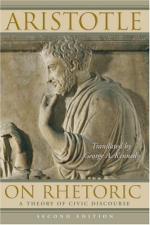
|
| Name: _________________________ | Period: ___________________ |
This test consists of 15 multiple choice questions and 5 short answer questions.
Multiple Choice Questions
1. In Aristotle's opinion, why should political rhetoric focus the most on sound argumentation?
(a) It was the most exciting.
(b) It was the most austere.
(c) It was the most flexible.
(d) It was the most important.
2. What was the basic method used in the a fortiori argument that Aristotle referred to in Book II, Chapter 23?
(a) To argue two entirely different things at once.
(b) To focus on several positions at once.
(c) To focus on only one position at a time.
(d) To prove one thing by proving another first.
3. According to Aristotle, what was the general difference between enthymemes and examples?
(a) Both enthymemes and examples were just as persuasive.
(b) Neither enthymemes nor examples were persuasive.
(c) Enthymemes were more persuasive than examples.
(d) Examples were more persuasive than enthymemes.
4. In the example provided by Aristotle, what was used to object to a common saying?
(a) Another common saying.
(b) An unknown situation.
(c) A common situation.
(d) A lesser known saying.
5. How did Aristotle describe arrhythmic prose for speech writing purposes in Book III, Chapter 1?
(a) Too restricted.
(b) Too unrestricted.
(c) Too unpredictable.
(d) Too predictable.
6. According to Aristotle, what should vivid descriptions always depict?
(a) Something that is in activity.
(b) Something that is not easily identified.
(c) Something that is easily identified.
(d) Something that is stationary.
7. What was used in the example that argued the existence of a "non-animal" in Book II, Chapter 24?
(a) Leaf.
(b) Tree.
(c) Rock.
(d) Fruit.
8. How did Aristotle define a maxim?
(a) A series of long statements about impractical conduct.
(b) A series of short statements about practical conduct.
(c) A short statement about practical conduct.
(d) A long statement about impractical conduct.
9. Which of the following examples best demonstrates Aristotle's theory of possibility in Book II, Chapter 19?
(a) Clouds and rain.
(b) Heat and sunshine.
(c) Thunder and lightening.
(d) Snow and ice.
10. As discussed in Book III, Chapter 12, what should legal rhetoric blend argumentation with?
(a) Effective delivery.
(b) Effective style.
(c) A familiar delivery.
(d) A familiar style.
11. How did Aristotle describe vivid speech?
(a) Very effective.
(b) Very exciting.
(c) Somewhat exciting.
(d) Somewhat effective.
12. How many general forms of enthymemes were discussed by Aristotle in Book II, Chapter 23?
(a) Twenty eight.
(b) Thirty four.
(c) Thirty eight.
(d) Twenty four.
13. Focusing on what they found useful, what did Aristotle say older people cared less about?
(a) The past and the opinions of others.
(b) Honor and the opinions of others.
(c) Honor and the past.
(d) Honor, the past, and the opinions of others.
14. How did Aristotle describe the difference between spoken and written prose?
(a) Spoken prose was generally more stylized and less complicated.
(b) Written prose was generally more stylized and complicated.
(c) Written prose was generally more stylized and less complicated.
(d) Spoken prose was generally more stylized and complicated.
15. In Book II, Chapter 26, how many common errors did Aristotle discuss?
(a) Three.
(b) None.
(c) One.
(d) Two.
Short Answer Questions
1. Continuing the theme of Aristotle's logic, what could be used to deduce the impossible?
2. Which characteristic did Aristotle think separated powerful people and wealthy people in general?
3. As pointed out by Aristotle, what advantage did a speech that included a surprise have for a listener?
4. Which one of the following was not included by Aristotle in the forms of surprises he mentioned?
5. In order to object to an argument using Aristotle's explanations, how might it be attacked?
|
This section contains 578 words (approx. 2 pages at 300 words per page) |

|




